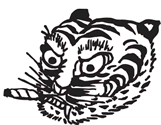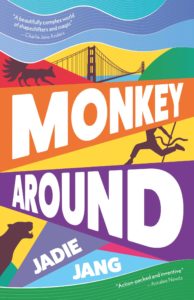Interview with Claire Light
In this new series of author interviews, THROUGHLINES presents writers with standard questions that reveal where their releases fit in the world of academia.
Claire Light is an activist and author, working in the Asian American and disabled communities. Monkey Around, her new novel written under the pen name Jadie Jang, meshes urban fantasy, ancient legend, and Bay Area activism into one thrilling adventure. In our interview, Light discusses how genre literature can provide much needed energy and commentary in the classroom.
THROUGHLINES: What class would your book be perfect to be taught in and why?
Claire Light: I’d love to see Monkey Around taught in a contemporary Asian American, ethnic, immigrant, or diasporic fiction course. Of course, Monkey Around is also perfect for courses on diversity in speculative fiction, contemporary fantasy, or genre fiction; and it would also be interesting in courses on Asian American culture, political and activist movements, and community and identity building. Monkey not only features characters who are Asian American and immigrant American, it also takes place in the world of ethnic community organizing, among characters who are hyper-aware of their identities, of identity formation, and of the importance of representation. Monkey can model the kind of awareness these classes teach and give a possible answer to “where do we go from here?”
THROUGHLINES: What themes in your book make it a good fit for Ethnic Studies, English, or other literature-based courses?
Light: Deracination, loss of culture through migration, strategies for adapting culture and skills to migration, diasporic communities, social justice activism, community responsibility and collective values … Monkey Around’s protagonist, Maya, is a mixed race transracial adoptee who studied Asian American Studies at UC Berkeley and stayed in the Bay Area to try to connect with her Asian roots. She works in the social justice communities of the Bay Area—is most recently involved in Occupy Oakland—and weaves in and out of newcomer and later generation ethnic enclaves, especially Asian ones. Maya encounters a Chicano family who consist of naguals—in this conception, people with inherited magic that allows them to shapeshift, and whose cultural role is as wise/medicine people. The family discovers an artifact dating back to the Conquest that allowed their Aztec ancestors to magically connect to whatever land they migrated to. The book is also populated with a plethora of other creatures from nonwestern cultures, each of whom have their own story.
THROUGHLINES: How can your book bring new perspectives to students?
Light: Speculative fiction offers a distorted mirror to real life situations and dynamics, both for the reader and writer. Magical analogies—like shapeshifting for code switching, or wearing glamours for “passing”—make sociological buzzwords fun, and give readers a bit of breathing room between themselves and the often troubling realities they live every day. Moreover, Asian American immigrant fiction has become a subgenre in itself, with tropes so road-worn, they can’t be properly experienced in fiction anymore, even when truthful or factual. Using the tropes of a different genre in a new way can refresh stories that have been deadened by retelling.
And Monkey Around tackles Asian American life even more directly, focusing on “professional Asian Americans”: those whose calling is to organize their communities and give them a voice. Strangely enough, “watching” the APIAs who redefine, on an ongoing basis, what it means to be APIA, inside an entertaining story—complete with magic, fight scenes, love triangles, and MacGuffins—humanizes their struggles and experiences in a way that mimetic fictions, with their dreamy, distancing, “poetic” language, increasingly can’t.
THROUGHLINES: Does your book feature any experiences, settings, or characters that you wish were better represented in academia?
Light: Monkey Around tells the story of a character who is both a female Monkey King, and a mixed race Asian American living and working in the SF Bay Area’s social justice activist communities. I’d like to see all of that better represented: the experiences of Asian Americans on the ground in activism—both advocacy and direct action—not as history but as a constant stream of contemporary life. I’d like to see mixed race characters in more than just identity-celebrating children’s books or filleted for their metaphorical power. I’d like to see the kinds of issues that urban fantasy grapples with better represented: young adults in professional urban settings dealing with structural and interpersonal power dynamics. Urban fantasy, with its coercive werewolf packs and bloodsucking vampire covens and asskicking enforcers falling in love with outcast enemies, is about nothing so much as structural power dynamics—more so than any other genre, including lit fic. But because of its status as a genre, what it has to say about these dynamics is largely ignored by the academy.
THROUGHLINES: What would it mean to you to see your book taught in classrooms?
Light: I think genre fiction too often gets siloed, not treated as part of the same stream as literary fiction. But often, the most experimentation on how to tell Asian American/diaspora stories happens in genre, particularly in speculative fiction. If Asian American studies is ignoring the incredible surge of Asian-culture-based fantasy by Asian diaspora writers that’s come upon us in the past decade, it really shouldn’t. In fact, I deliberately chose to write speculative fiction because I found Asian American mimetic fiction too stuck in narrative trammels—be they “ethnic lit” ruts, or “lit fic” ones. Narrative straits have hemmed in Asian American fiction too much already; already stories that lit fic can’t find ways to tell are finding amazing new paths in speculative fiction, enabled by the inherent tropes, rather than hindered by them. Our communities would be richer if our imaginations were freed up a little more by our formal educations.



Leave a Comment
We'd love to know what you think.